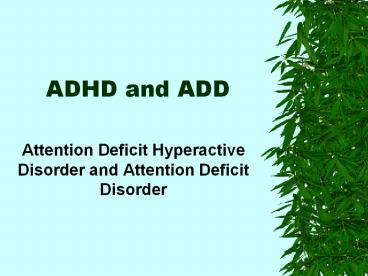ADHD%20and%20ADD - PowerPoint PPT Presentation
Title:
ADHD%20and%20ADD
Description:
Has difficulty remaining seated when required to do so ... Has difficulty awaiting turn in games or group situations ... Has difficulty sustaining attention in ... – PowerPoint PPT presentation
Number of Views:92
Avg rating:3.0/5.0
Title: ADHD%20and%20ADD
1
ADHD and ADD
- Attention Deficit Hyperactive Disorder and
Attention Deficit Disorder
2
What is ADHD?
- Biologically based behavioral disorder that
affects between three and six percent of
elementary school-aged children in U.S. - Defined by the Diagnostic and Statistical Manual
(DSM VR) of the American Psychiatric Association - ADD is attention deficit without the
hyperactivity.
3
Causes of ADHD
- Environmental factors
- Genetics
- Brain disturbances
4
ADHD
- All age groups can be affected, from young
children to adults. - More boys than girls are diagnosed with ADHD.
5
ADHD
- To be diagnosed with ADHD
- A child must exhibit excessive and/or
inappropriate overactivity, inattentiveness or
impulsiveness for a period of more than six
months. - A child may exhibit all of these traits, or just
one or two, to be diagnosed with the condition.
6
Behaviors of an ADHD Child in the Classroom
- ADHD children commonly fail to complete homework
assignments - Inattentive to classroom instruction
- Often write illegibly
- Frequently provoke others physically
- Often fidgets with hands or feet or squirms in
seat (in adolescents this may be limited to
subjective feelings of restlessness).
7
Behaviors
- Has difficulty remaining seated when required to
do so - Is easily distracted by extraneous stimuli
- Has difficulty awaiting turn in games or group
situations - Often blurts out answers to questions before they
have been completed
8
Behaviors
- Has difficulty following through on instructions
from others (not due to oppositional behavior or
failure of comprehension) e.g. fails to finish
chores - Has difficulty sustaining attention in tasks or
play activities - Often shifts from one uncompleted activity to
another
9
Behaviors
- Has difficulty playing quietly
- Often talks excessively
- Often interrupts or intrudes on others, e.g.
butts into other childrens games - Often does not seem to listen to what is being
said to him or her
10
Behaviors
- Often loses things necessary for tasks or
activities at school or at home (e.g. toys,
pencils, books). - Often engages in physically dangerous activities
without considering possible consequences (not
for the purpose of thrill-seeking) e.g. runs into
street without looking.
11
How is ADHD Diagnosed?
- Most accurate diagnosis is from a team of
child-care professionals carefully evaluating a
child over a period of time in a variety of
settings. - Process usually includes education, psychological
and medical assessments.
12
- Process may include the following professionals,
as well as parents of the child - Pediatrician
- School teacher(s)
- Child psychiatrist
- Pediatric neurologist
- School psychologist
13
- Conners Questionnaire one instrument used to
assist in diagnosis - PET scan
- Biological markers within the brain
14
Brain scan images produced by positron emision
tomography (PET) show differences between an
adult with Attention deficit Hyperactivity
Disorder (ADHD) (right) and an adult free of the
disease (left).
15
How is ADHD Treated?
- Multimodal therapy considered the best treatment
approach - Psychological counseling
- Special education
- Medication
- Dexedrine
- Ritalyn
- Cylert































